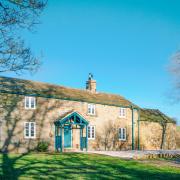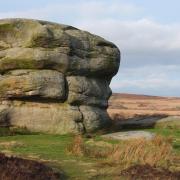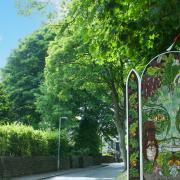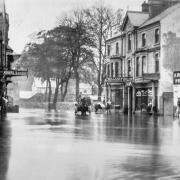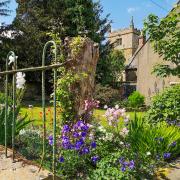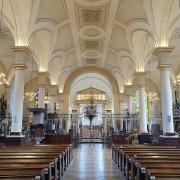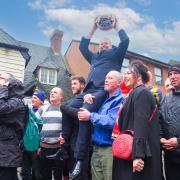Janine Sterland meets the dedicated team of volunteers tasked with saving a vital piece of our county’s industrial and social heritage
The attraction of the Cromford Canal is obvious at first glance. Its picturesque winding towpaths and serene waterways reflect an industrial legacy of rare listed buildings.
Its thriving nature reserve of semi-rural ancient woodland with UNESCO World Heritage Site status inspires, calling thousands of cyclists, photographers and ramblers each year.
And yet the canal’s tranquillity is in stark contrast to its bustling industrial past, when it was an area of strategic significance throughout the Industrial Revolution heydays.

‘Water was the only available source of energy to power factory production - steam engines only became efficient enough to power factories about 50 years later,’ explains Ian Hooker, volunteer at Derbyshire Wildlife Trust’s Aqueduct Cottage restoration project.
‘Richard Arkwright, widely regarded as a founding father of the Industrial Revolution, moved to Cromford to make use of waterpower and the whole story of the mills is built throughout the Derwent Valley.
An unassuming centrepiece of this magnificent area is Aqueduct Cottage, built in 1802. Its story is one of prominence, decay and, ultimately, revival.

‘The key to understanding the importance of Aqueduct Cottage in heritage terms is in the fact it was built in that position,’ reveals Ian.
‘It was not built there because it was a picturesque or attractive place; it was for a specific reason - for a lockkeeper to manage the operation of the lock connecting the Lea Wood Arm to the Cromford Canal.’
‘Because it had to be built there for that purpose, it demonstrates the importance that water had in relation to economic development.
‘In fact, local industrialist Peter Nightingale was only permitted to connect the canal which served his mills at Lea Bridge and Lea Wood on the condition that the water in the arm was maintained one foot above the level in the Cromford Canal – meaning he could not use water required by other industries.’
Nightingale Heritage
Having employed someone to manage the lock, housing for the lockkeeper on Peter Nightingale’s site was a necessity and it was this scenario which led to the building of Aqueduct Cottage in 1802.
Standing less than 50 yards from the aqueduct which carries the Cromford Canal across the Derwent River, the cottage acquired the logical name it is so widely and affectionately known by to this day.
‘The estate eventually passed to his nephew William Edward Shore (then still a child) who adopted the name of Nightingale in order to inherit,’ reveals Ian.
‘William may not be universally known but his daughter certainly is - one Florence Nightingale. The estate (including Aqueduct Cottage) remained in the ownership of the Nightingale family until its sale in 1947.’
There are no known historic documents of Florence visiting the cottage, nor direct evidence that the Nightingale family permitted members of the public onto their land.
However, records following the sale of the estate suggest that for around half a century the community was allowed to walk through the woodland.
‘The local Scouts camped annually on the Tunnel Field and the towpath was a regular access route,’ continues Ian.
‘This was why, when the sale and development of the woodland and the cottage was imminent, the local community and other visitors acted to take it into ownership, which would guarantee that it remained open to the public.
‘It’s a beautiful stretch of natural habitat teeming with industrial archaeological interest and Aqueduct Cottage is a big part of that, despite the unfortunate fact that the cottage eventually fell into despair and became derelict, with the last tenant leaving in 1968.’

Community Support
Fast forward to 1996, 28 years after Aqueduct Cottage began its lonely decline, Lea Wood came on the market, resulting in a London-based developer presenting an offer to purchase the land.
‘As a result of this, the Lea Wood Trust was formed by local villagers in Lea, Dethick and Holloway,’ explains Aqueduct Cottage volunteer Ron Common.
‘The intention was to raise the funds needed to preserve and protect the natural beauty and wildlife in the wood in order to save it from developers.
‘Amazingly, over the course of just one weekend, £115,000 was raised, which enabled the Lea Wood Trust to secure the purchase in 1997.’
After several years of ownership, the 74-acre woodland, including the derelict Aqueduct Cottage, was gifted to Derbyshire Wildlife Trust in 2012.
A plan for re-vitalising the woodland was immediately put in place, but the future – if there was to be one - of the cottage remained unclear until 2013, when Derbyshire Wildlife Trust embarked on a five-year programme, funded by the National Lottery, called DerwentWISE.
‘Its aim was to engage the public in a variety of natural and cultural conservation projects in the Lower Derwent Valley,’ says Ron. ‘Aqueduct Cottage was one of 50 projects within the programme.’
Having joined the team as a volunteer project manager in 2016, Ron was given the remit of reviewing the cottage development options contained in a report from Mansel Architects, commissioned back in 2013. It was, says Ron fondly, ‘the beginning of a six-year love affair’ with Aqueduct Cottage.
Within three months, Ron submitted his recommendations, supporting business case and detailed restoration plan to the Derbyshire Wildlife Trust.
‘Reading the Mansel report was a pivotal moment,’ recalls Ron. ‘I was completely captivated by the old photos of the cottage, its beautiful location, as well as the fascinating information uncovered about its historical connections to the Nightingales and the industrial development of the valley as a whole. I realised very quickly this was no ordinary workers cottage.’
During his first visit to the site in August 2016, Ron assessed the damage that had been caused to the cottage as a result of having been left empty for almost 50 years.

‘The cottage by this point was roofless, hidden by trees and covered with vegetation,’ he describes. ‘Walls were either badly cracked or crumbling away, with parts of the structure close to collapse.
‘Yet there was a real sense of magic about the place that was palpable. The visualisation of its restoration was a really exciting thought.
‘I visited the place several times after that first encounter and often local people out for a stroll along the canal would stop to enquire about the cottage or to share their memories.
It was so obvious that this was a much-loved and cherished building within the local community. There was clearly a compelling case to save the cottage, it was just a matter of how.’

Saving Aqueduct Cottage
Having accepted the business case for restoring the cottage into a dual-purpose information and activity centre in 2017, the challenge for Derbyshire Wildlife Trust was where to find the resources, funding and expertise required for what would be a complex heritage restoration.
‘With no funds in the kitty, the only work we were able to do initially was to remove the trees which had engulfed the cottage, as well as implementing some emergency stabilisation work’ Ron explains.
Against this backdrop, the cottage’s future remained uncertain but, driven by his ever-increasing passion for saving the building, Ron pursued a variety of fund-raising ideas.
‘Saving the cottage had become a personal mission by this time,’ says Ron.
‘Although it was a huge challenge to raise the amount of money required, based on the local affection for the cottage, I decided to set up a Facebook group called ‘Friends of Aqueduct Cottage.
‘I’d previously used Facebook for another charity project I had worked on and knew it was a good resource for both engaging and informing people, as well as providing an effective way of providing updates.’
The results were profound. Membership grew, not just locally, but nationally and even internationally too as memories, stories and photographs of the cottage were shared.
‘Volunteers researched its history, some donated paintings to cover the boarded-up windows, whilst others helped with photo exhibitions to raise awareness of the project,’ recalls Ron.
‘Networking events also took place with local individuals and businesses in order to gain support, alongside social history research which helped encourage local interest.’
The project then took on a very personal tone as, in June 2017, the group came across Fay Bark, one of the few surviving former residents of the cottage.
‘Fay provided some truly fascinating insights into life at this remote cottage back in the 1950s, along with a series of amazing sketches detailing what was in and around their family home.
‘This and other family stories going back over 100 years were collected and shared and this was really important in providing a fascinating first-hand social history of the cottage; it really helped bring the building to life.
‘The stories provided a real sense of what it was like living in this remote worker’s cottage in a by-gone age.’
Following the phenomenal success of the Aqueduct Cottage’s Facebook group, which by this point had attracted several hundred members - supplemented with a successful ‘Buy a Brick’ fundraising initiative as well as several corporate and private donations - around £95,000 has been raised towards the project.
‘The support from the community has been absolutely fantastic and equally inspiring,’ Ron says.
‘In addition to these crucial cash donations, thousands of pounds worth of materials and complimentary services have been provided, plus over 7,500 hours of volunteer time – a staggering amount of time generously donated.
‘Also, the Derbyshire Historic Buildings Trust has played an important role as partners to Derbyshire Wildlife Trust. Their associate, James Boon, volunteered his services as a member of restoration team in June 2018 to lead the planning process and help steer the restoration.’

Volunteer Dedication
With such vital contributions in place, the project was finally underway. With planning consent received from Amber Valley District Council in July 2019, a team of volunteers were recruited the following October to assist with the restoration work, including the key appointment of restoration builder Andrew Churchman.
‘The commitment and dedication from the team of volunteers and local businesses from the community has underpinned the success of the whole project,’ Ron says proudly.
‘I’ve been amazed by the number of people who have been happy to freely give their time and expertise to help out, even throughout physically challenging situations. Even during Covid, our builder Andrew Churchman managed to keep the project moving forward by working alone for several weeks.
‘Add to this the pride of saving a beautiful and hugely significant local historic building for the benefit of the community, and it makes me feel incredibly privilege to be involved.
‘In particular, the contribution from the volunteers and the positive community support will be my abiding memory.’
By October 2020, Andrew had completed the stonework repairs and the volunteers were back on site after the Covid lockdown, ready to take delivery of the roof timbers.
‘The logistics of material delivery presented a challenge,’ accepts Ron. ‘For example, how would we get the heavy seven-metre timber sections to site, given the track to the Wharf Shed was too narrow for the supplier’s lorry.’
Thankfully, as Ron explains, the Friends of Cromford Canal agreed the use of their canal boat, Birdswood, and in a scene of great serendipity history repeated itself as the cargo was loaded onto the boat at the Cromford Wharf and carried one and a half miles along the canal.
‘This was much in the same way as the original roof timbers would have been delivered 220 years ago when Aqueduct Cottage was first being constructed,’ explains Ron. ‘The story attracted a lot of local media attention and there was quite the turnout of spectators – it was just fantastic.’
The other major challenge, says Ron, has been the famously-fickle Derbyshire weather.
‘Our dedicated volunteers are prepared to work whatever the conditions, but the lime-mortar being used for stone repairs, pointing, and the like simply cannot be used during colder periods.

‘This means progress, which can be manually intensive, is hampered during the winter months, although, the work is highly satisfying and several have commented on the wellbeing benefits of volunteering.’
Indeed, over the three years, 60 volunteers have participated at various stages of the project.
Since 2021, this has now settled to a dedicated core team of around 20, with many being encouraged to lend their help by the cottage’s charming setting as well as the group comradery.
‘Our volunteers have found that working in the outdoors in a beautiful natural environment – which this undoubtedly is – really rewarding,’ continues Ron.
If you add to that the benefits of exercise and fresh air, plus the positive interaction with a great bunch of people, it’s no surprise that volunteers see it as a highly pleasurable activity, even though some of the tasks have been demanding.
‘For example, in the beginning, volunteers had to clear a metre-thick pile of earth, tree roots and rubble which had accumulated in the roofless cottage over several decades. Over 30 tons of debris was removed - filling six skips!
‘The team also completed all the landscaping work, including removing several tree roots, designing and creating the two cottage gardens and the building of dry-stone walls and steps.’
One of the biggest challenges, he describes, was the constructing of 50 steps up the steep hillside into the Lea Wood Nature Reserve, with tons of soil and rock having to be dug by hand, separated, and carried away to allow for steps with handrails to be installed up the hillside.
‘It was a herculean task,’ smiles Ron, ‘but the finished result earned the praise of all those who visit the woodland.’
As the project progressed, the volunteers became increasingly involved in the more technical restoration tasks, with training taking place in traditional building methods such as lime-mortaring and lime-pointing, plus some elements of stone masonry.
‘These methods ensured the project’s desire to undertake a ‘light touch’ restoration, using traditional methods and materials to recreate the main structure of the cottage as close as possible to their original external appearance when viewed from the canal towpath.
‘This has been informed by historic and archive photographs as well as oral history. We also intend to use examples of such historic imagery within the cottage as part of its final completion plans.’

A Cottage, Reborn
With plans to open in Spring 2023, Derbyshire Wildlife Trust have positioned the cottage as a gateway to the Lea Wood Nature Reserve, with plans for the ground floor to contain interpretations about the history of the cottage.
These will include details on the abundant wildlife in Lea Wood as well as Derbyshire Wildlife Trust’s plans to increase the bio-diversity of the Lower Derwent Valley by creating ‘wildlife corridors’.
‘We are also delighted that the first-floor area is designed for educational purposes and the teaching of traditional craft practices - the restoration of the cottage really lends itself perfectly to this and also ensures that important heritage skills can be passed onto the next generation,’ concludes Ron.
‘We are all immensely proud to have been involved in saving this important piece of our heritage which, ultimately, is for the benefit of the whole community. It’s been an astonishing achievement.’




